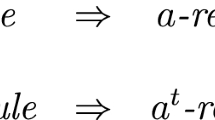Abstract
An R-module V is a ray if for every R-module W, the R-homogeneous functions from V to W are additive. We use properties of the lattice of submodules of \( V, {\cal L}(V) \), to determine conditions for V to be a ray. We also use the lattice structure of \( {\cal L}(V) \) to further study those rings such that every R-module V is a ray. As a result, we can characterize all semisimple modules which are rays.
Similar content being viewed by others
References
Akkurt, M., Barker, G.P., Wild, M., “Subalgebras of M n(F) with a distributive lattice of invariant subspaces,” submitted.
Albrecht, U. and Hausen, J., “Nonsingular modules and R-homogeneous maps,” Proc. Amer. Math. Soc, 123 (1995), 2381–2389.
Fuchs, P., Maxson, C.J., and Pilz, G., “On rings for which homogeneous maps are linear,” Proc. Amer. Math. Soc, 112 (1991), 1–7.
Krempa, J. and Niewieczerzal, D., “On homogeneous mappings of modules,” Contributions to General Algebra, 8 (1991), 123–135, Hölder-Pichler-Tempsky, Wien.
Maxson, C.J., “Forcing linearity numbers for projective modules,” J. Algebra, 251 (2002), 1–11.
Maxson, C.J. and Meyer, J.H., “Forcing linearity numbers,” J. Algebra, 223 (2000), 190–207.
Maxson, C.J. and Meyer, J.H., “Forcing linearity numbers for modules over simple domains,” Results in Math., 42 (2002), 114–121.
Maxson, C.J. and van der Merwe, A.B., “Forcing linearity numbers for finitely generated modules,” Rocky Mt. Journal Math., (to appear).
Maxson, C.J. and van der Walt, A.P.J., “Centralizer near-rings over free ring modules,” J. Austral. Math. Soc, 50 (1991), 279–296.
McConnell, J.C. and Robson, J.C., Noncommutative Noetherian Rings, Grad. Stud. Math., 30, Amer. Math. Soc, 1987.
Meyer, J.H., “Forcing linearity: A survey,” Notices of the South African Math. Soc, 34 (2003), 34–50.
Rowen, L., Ring Theory, Vol. I, Academic Press, Inc., New York, 1988.
Vamos, P., “Finitely generated Artinian and distributive modules are cyclic,” Bull. London Math. Soc, 10 (1978), 287–288.
Wild, M., “The fundamental theorem of projective geometry for an arbitrary length two module,” submitted.
Wild, M., “When are homogeneous bijective functions linear?” In preparation.
Author information
Authors and Affiliations
Corresponding author
Rights and permissions
About this article
Cite this article
Maxson, C.J., Wild, M. When are Homogeneous Functions Linear?. Results. Math. 47, 122–129 (2005). https://doi.org/10.1007/BF03323017
Received:
Published:
Issue Date:
DOI: https://doi.org/10.1007/BF03323017



